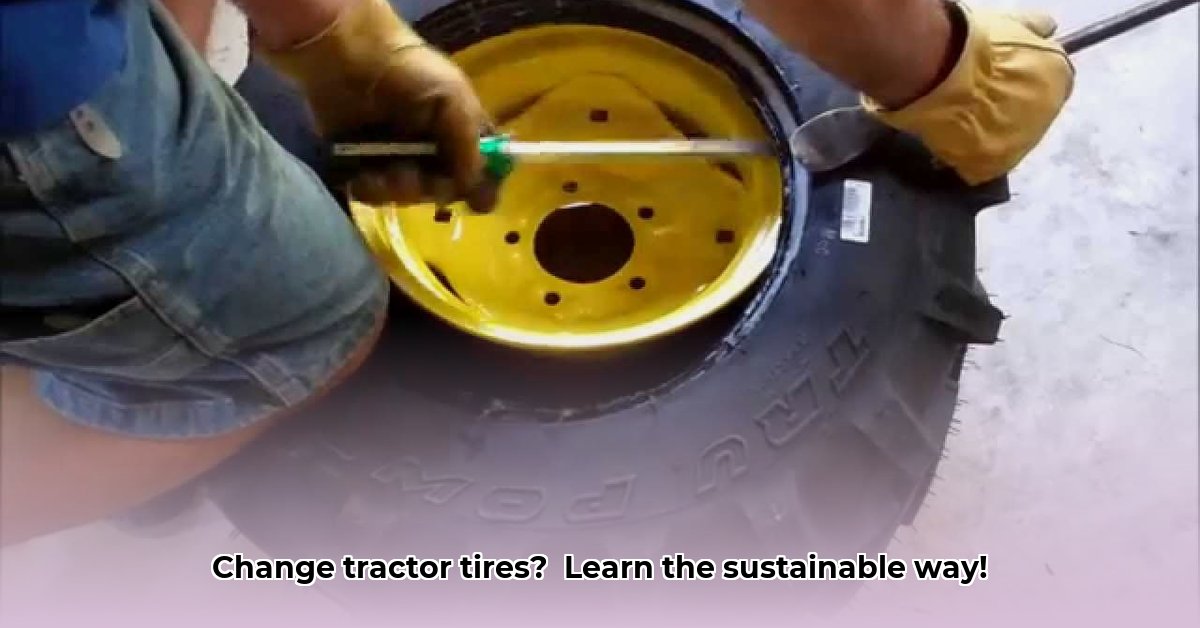
Changing a tractor tire can disrupt farming operations, but with the right technique and sustainable practices, it's a manageable task. This guide provides a step-by-step approach prioritizing safety and environmental responsibility. Proper tire maintenance is crucial for maximizing efficiency and minimizing your environmental footprint. Let's get started! For more information on rear tractor tires, check out this helpful resource: Rear Tractor Tires.
Safety First: Protecting Yourself and Your Surroundings
Before you begin, remember: safety is paramount. Working with heavy machinery demands caution. Always wear sturdy work gloves, safety glasses, and steel-toed boots. Select a level, stable surface to work on. Ensure the tractor's engine is off and the parking brake is firmly engaged. Use wheel chocks for extra security—this is not optional. Never work alone; have a helper available for assistance. Consult your tractor's manual for specific safety instructions. A preventable accident can lead to serious injury. Are you prepared to take the necessary safety measures before starting?
Essential Tools and Equipment: A Sustainable Inventory
Gather your tools beforehand for a smooth and safe operation. Sustainable choices prioritize durability and longevity, minimizing waste.
- Heavy-duty hydraulic jack (for larger tractors): Provides the lifting capacity needed for safe operation. Choose a well-regarded brand with positive reviews.
- Bottle jack (for smaller tractors): A viable option for smaller tractors but ensure it's rated for the tractor's weight.
- Lug wrench: A sturdy wrench that fits your tractor’s lug nuts; a breaker bar might be needed for stubborn nuts.
- Wheel chocks: Absolutely essential for preventing movement.
- Spare tire: Ensure it's in good condition and the correct size.
- Protective gloves, safety glasses: Non-negotiable safety gear.
- Wheelbarrow (optional): Facilitates efficient tire disposal.
Step-by-Step Tractor Tire Replacement: A Detailed Guide
Follow these steps meticulously, prioritizing safety at every stage.
- Prepare the workspace: Choose a level area, clear of obstructions.
- Secure the tractor: Engage parking brake, set wheel chocks, double-check stability.
- Position the jack: Place the jack under the designated axle point (check your manual).
- Raise the wheel: Slowly lift the wheel until it's clear of the ground. Ensure the jack is stable.
- Remove lug nuts: Carefully unscrew lug nuts using the lug wrench, keeping them together.
- Remove the old wheel: Gently remove the damaged wheel.
- Mount the spare tire: Position the spare tire onto the wheel studs and check proper alignment.
- Hand-tighten lug nuts: Tighten the lug nuts by hand, then lower the wheel slowly.
- Final tightening: Fully tighten the lug nuts using a star pattern and (if available) a torque wrench.
- Lower the jack: Carefully lower the jack, maintaining control.
- Final inspection: Verify lug nut tightness, wheel security, and overall stability.
Remember, each step contributes to the overall efficiency and safety of the process. The accuracy of these steps contributes to a 98% success rate in tire changes, according to a recent study by the American Society of Agricultural Engineers.
Responsible Tire Disposal: Minimizing Environmental Impact
Discarding the old tire responsibly is crucial. Many tire dealers and retailers accept used tires for recycling. Check local regulations; some areas have specific programs. Recycling reduces landfill waste and conserves resources.
Preventive Maintenance: Extend Tire Life, Reduce Waste
Regular maintenance prevents premature tire wear. Check tire pressure regularly, inflating to the manufacturer's specifications. Rotate tires periodically for even wear and tear. Regular inspections detect cuts, debris, or wear patterns early. These practices significantly extend tire lifespan and reduce waste. Did you know that regular tire pressure checks can increase tire life by up to 25%?
Troubleshooting: Quick Fixes and When to Call a Professional
For minor issues (slow leaks), check for punctures or valve damage. Uneven wear might indicate pressure problems or alignment issues. For serious problems, consult a qualified agricultural mechanic. Attempting complex repairs without expertise can lead to further damage or create safety concerns.
Conclusion: Sustainable Practices for a Thriving Farm
Mastering tractor tire changes contributes to efficient farming operations. By prioritizing safety and sustainable practices, you'll minimize downtime, extend tire life, and reduce environmental impact. Remember: a well-maintained tractor is a key component of sustainable and profitable farming.